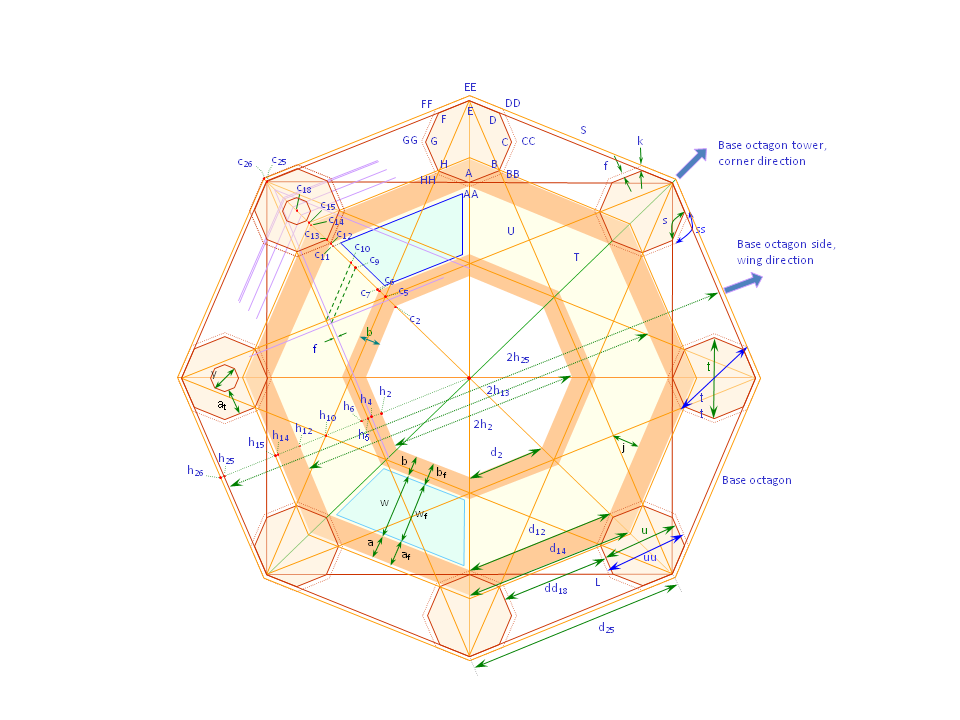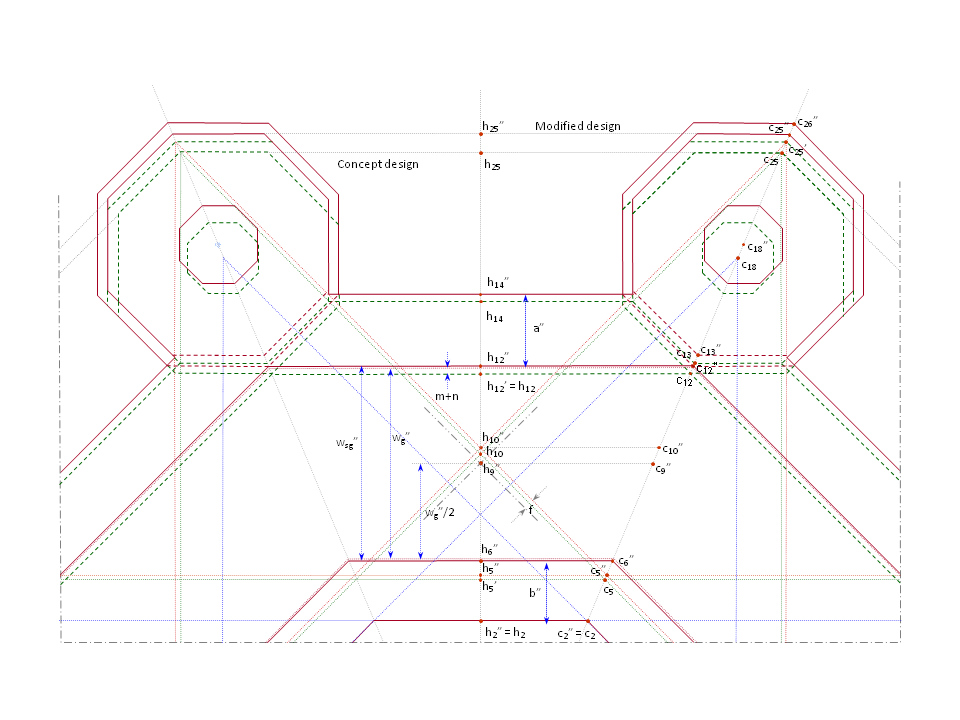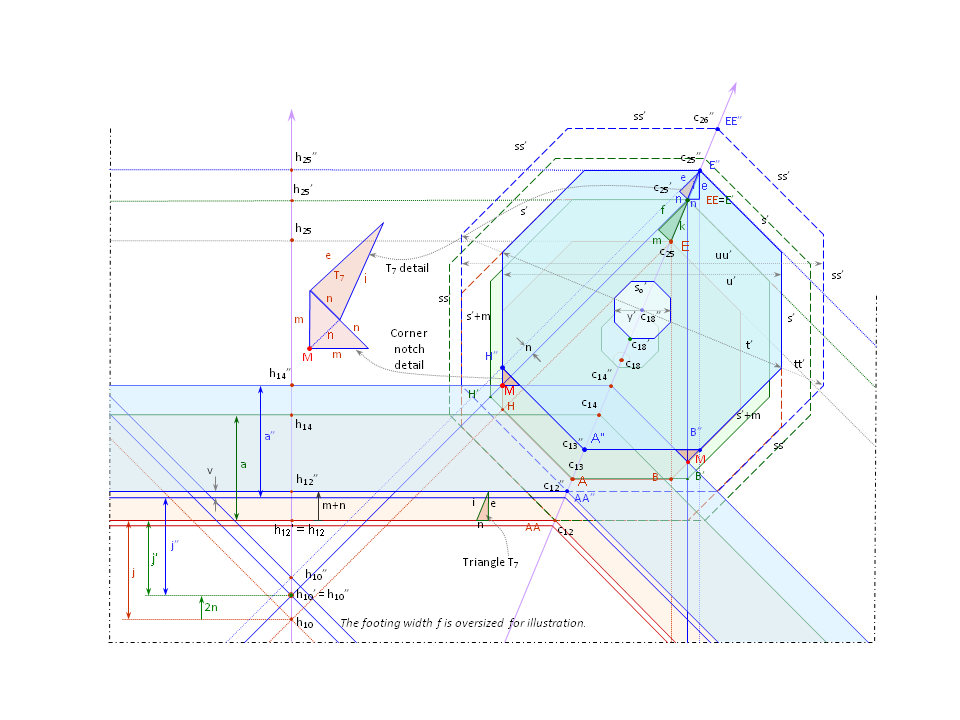Page 4
Mathematical Model Description
A spreadsheet layout of the mathematical model is shown on page 3. It is a succession of variable definitions on consecutive spreadsheet lines, following a heading (the top ten lines). The heading includes reference information about this spreadsheet (column A), and pre-calculated constants (columns E-G). The pre-calculated constants are the trigonometric values for the angles in the octagon characteristic triangle.
The information on each line is arranged by columns; the headings for the columns are on rows 11-12. The data include a description of the variables (col. B), the variable name (col. C), the formula for the variable definition (col. D), and an actual calculation of the variable, both in feet (col. E) and meters (col. F). The unit of measurement is set in cell F11 and is a variable in this mathematical model; a discussion of the unit of measurement follows on page 7.
The definition lines are grouped into two major sections, one at the top dealing with the concept design (row 14) and a second further down (row 72) dealing with the tower modification. Each section is broken down in smaller logical groups under a descriptive heading. The spreadsheet ends with the definition of a number of corollary variables.
The variable definition includes occasionally a second mathematical definition, a check on the preceding definition (i.e., rows 33 and 38), as well as notes and verification lines (i.e., rows 66 and 78). This rendition of the mathematical model includes 129 definition lines.
The plant forms have variable names, for example: t for the octagon major diagonal, u for the octagon minor diagonal, s for the octagon side, etc. Capital letters are used for the base octagon and small letters are used for the tower octagon (i.e., S for the side of the base octagon and s for the side of the tower octagon). The variable names for the footing octagon are the same alphabet letter doubled up; if s is the side of the tower octagon, ss is the side of the footing octagon.
The algorithm for the concept design and the algorithm for the modified plant design provide the context and detailed explanation for each of these variable names, and also the mathematical definitions. A graphical reference provides a quick visual definition of the variables, Figures 4, 5, and 6.
Figure 4. Graphical references for math variables – plant.

Figure 5. Graphical references for math variables – wing detail.

Figure 6. Graphical references for math variables – tower detail.

Three variables are indexed numerically; they measure the same feature at different distances from the center in the plant octagon:
- The variable c measures distance from the center of the plant octagon along the octagon corner direction
- The variable h measures a similar distance along the plant octagon wing (side) direction
- The variable d measures the octagonal side at different distances from the center of the plant octagon
For example: the corner of the courtyard octagon is c2; the outer corner of the tower octagon, referred elsewhere as tower corner E, is c25 in this mathematical model. Similarly d2 is the side of the octagon at the courtyard perimeter, and d25 is the side of the base octagon, also referred to as S.
The distinction among the same variables that change location and/or dimension going from concept design to modified design is made with a superscript: none for the concept design, prime (') for the tower enlargement and double prime (") for the tower relocation.
The variable superscript progression is frozen at the stage in which its definition does not change anymore in the algorithms. For example, the side of the tower s changes with the tower octagon enlargement, assuming the dimension s'. However, it does not change anymore with the tower relocation; it remains at the definition s' at the end of the mathematical model.
The indexed variables, c, d, and h, are also subject to change in the modified plant design and are relabeled with the prime and double-prime notation accordingly.
There are few incidental variables with unique names or subscripts, with an explanation in the description column.
The mathematical definition column gives the mathematical formula. Most of these formulas are addressed in the geometric model presentations. The rest are based on geometric relationships.
The mathematical model defines forms dimensions in terms of units, column E of the spreadsheet on page 3.
The independent variable L, which is the side dimension of the base square, is assigned a dimension of 128 units at the head of the model, line 15, column E. An explanation for this assignment follows on page 5. All other variable dimensions are calculated derivatively from this measure.
Scholars have considered various historical units of measurements: the palm, the cubit, the Roman foot, etc. The unit of measurement is assigned a metric value in cell F11, the spreadsheet on page 3.
Column E provides the calculation of the variable dimension in Castel del Monte units. These measures are rescaled in column F, spreadsheet on page 3, for the metric equivalent, using the metric value assigned to the unit dimension in cell F11.
All dimensions are ultimately calculated in meters (col. F), because the known dimensions from published literature are reported in meters.

